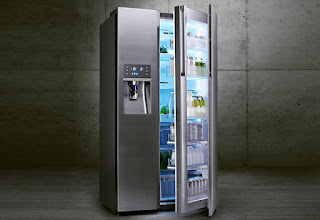Inventions History Machines
A refrigerator consists of a thermally insulated compartment and a heat pump (mechanical, electronic or chemical) that transfers heat from the inside of the fridge to its external environment so that the inside of the fridge is cooled to a temperature below the room temperature. Refrigeration is an essential food storage technique in developed countries. The lower temperature lowers the reproduction rate of bacteria, so the refrigerator reduces the rate of spoilage.
 Before the invention of the refrigerator, icehouses were used to provide cool storage for most of the year. Placed near freshwater lakes or packed with snow and ice during the winter, they were once very common. Natural means are still used to cool foods today. On mountainsides, runoff from melting snow is a convenient way to cool drinks, and during the winter one can keep milk fresh much longer just by keeping it outdoors. The word "refrigeratory" was used at least as early as the 17th century
Before the invention of the refrigerator, icehouses were used to provide cool storage for most of the year. Placed near freshwater lakes or packed with snow and ice during the winter, they were once very common. Natural means are still used to cool foods today. On mountainsides, runoff from melting snow is a convenient way to cool drinks, and during the winter one can keep milk fresh much longer just by keeping it outdoors. The word "refrigeratory" was used at least as early as the 17th century
The history of artificial refrigeration began when Scottish professor William Cullen designed a small refrigerating machine in 1755. Cullen used a pump to create a partial vacuum over a container of diethyl ether, which then boiled, absorbing heat from the surrounding air. The experiment even created a small amount of ice, but had no practical application at that time.
In 1805, American inventor Oliver Evans described a closed vapor-compression refrigeration cycle for the production of ice by ether under vacuum. In 1820, the British scientist Michael Faraday liquefied ammonia and other gases by using high pressures and low temperatures, and in 1834, an American expatriate in Great Britain, Jacob Perkins, built the first working vapor-compression refrigeration system. It was a closed-cycle device that could operate continuously. A similar attempt was made in 1842, by American physician, John Gorrie, who built a working prototype, but it was a commercial failure. American engineer Alexander Twining took out a British patent in 1850 for a vapor compression system that used ether.
 Before the invention of the refrigerator, icehouses were used to provide cool storage for most of the year. Placed near freshwater lakes or packed with snow and ice during the winter, they were once very common. Natural means are still used to cool foods today. On mountainsides, runoff from melting snow is a convenient way to cool drinks, and during the winter one can keep milk fresh much longer just by keeping it outdoors. The word "refrigeratory" was used at least as early as the 17th century
Before the invention of the refrigerator, icehouses were used to provide cool storage for most of the year. Placed near freshwater lakes or packed with snow and ice during the winter, they were once very common. Natural means are still used to cool foods today. On mountainsides, runoff from melting snow is a convenient way to cool drinks, and during the winter one can keep milk fresh much longer just by keeping it outdoors. The word "refrigeratory" was used at least as early as the 17th centuryThe history of artificial refrigeration began when Scottish professor William Cullen designed a small refrigerating machine in 1755. Cullen used a pump to create a partial vacuum over a container of diethyl ether, which then boiled, absorbing heat from the surrounding air. The experiment even created a small amount of ice, but had no practical application at that time.
In 1805, American inventor Oliver Evans described a closed vapor-compression refrigeration cycle for the production of ice by ether under vacuum. In 1820, the British scientist Michael Faraday liquefied ammonia and other gases by using high pressures and low temperatures, and in 1834, an American expatriate in Great Britain, Jacob Perkins, built the first working vapor-compression refrigeration system. It was a closed-cycle device that could operate continuously. A similar attempt was made in 1842, by American physician, John Gorrie, who built a working prototype, but it was a commercial failure. American engineer Alexander Twining took out a British patent in 1850 for a vapor compression system that used ether.
The first practical vapor compression refrigeration system was built by James Harrison, a Scottish Australian. His 1856 patent was for a vapor compression system using ether, alcohol or ammonia. He built a mechanical ice-making machine in 1851 on the banks of the Barwon River at Rocky Point in Geelong, Victoria, and his first commercial ice-making machine followed in 1854. Harrison also introduced commercial vapor-compression refrigeration to breweries and meat packing houses, and by 1861, a dozen of his systems were in operation. More details
